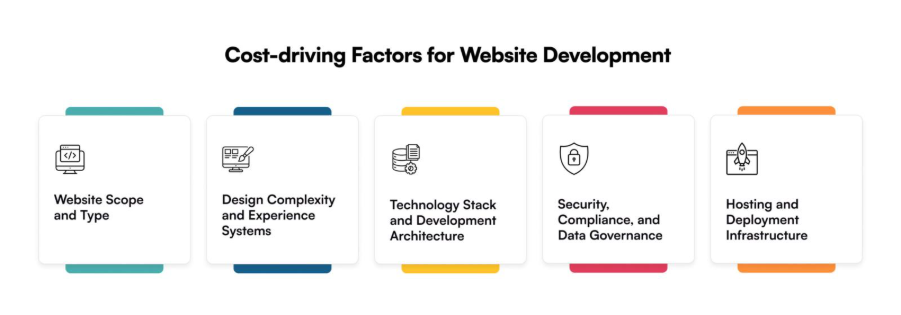Imagine this: your enterprise is ready to revamp its digital presence. You have aligned your branding, finalized the objectives, and set your expectations for performance. But the moment you start requesting quotes for your new website, the numbers vary drastically. One agency quotes $10,000, another says $80,000, and yet another pushes the figure beyond $150,000.
That’s when the confusion begins.
If you are a business owner, you have probably faced this exact uncertainty
But why does the website development cost differ so widely? The truth is, there is not a one-size-fits-all answer because your website cost directly depends on its scale, functionality, and infrastructure depth.
According to GoodFirms, the average cost to develop a website ranges between $3,000 and $150,000+, depending on requirements like design complexity, backend integrations, and compliance needs.
For enterprises, this gap is even broader because performance, scalability, and security are non-negotiable. A startup landing page may cost a few thousand dollars, but an enterprise web portal with dashboards, multi-region deployment, and cloud integrations could easily cross six figures.
Here’s a simplified breakdown to set the context:
| Website Type | Purpose | Approx. Website Development Cost (USD) |
| Basic business website | Brand presence, minimal integrations | $5,000 – $10,000 |
| Corporate website | Multi-page, CMS-enabled, moderate traffic | $10,000 – $25,000 |
| eCommerce website | Product listings, cart, secure checkout | $25,000 – $60,000 |
| Enterprise-grade platform | APIs, cloud hosting, data security, scalability | $60,000+ |
These figures only set the base layer. The real cost of development lies in the complexity of integrations, the design-first approach, and the architecture that powers it.
At Galaxy Weblinks, a trusted website development company, we have seen enterprises underestimate their website cost not because of mismanagement, but because most industry oversimplifies the equation. The truth is:
“Website development cost is not just about coding hours—it’s about engineering a digital system that grows with your business.”
That’s where this blog goes deeper. Unlike surface-level guides, this piece will break down the average cost to develop a website with real technical factors in play — from design systems to infrastructure, deployment, and post-launch maintenance.
Below, we will decode the complete deduction of what defines your website development cost, helping you make confident, data-driven budgeting decisions.
Factors That Influence Website Development Cost

Once you start estimating your website development cost, you will realize that numbers vary not just by company but by what is happening behind the build. Two websites may look similar on the surface, yet one can cost twice as much because enterprise websites are not priced on visuals alone. They are priced on what powers them underneath.
Below are the key factors that truly decide the average cost to develop a website, and why understanding them early helps you budget smarter.
Website Scope and Type
Your website’s scope defines its cost foundation. A basic business website serves as a digital brochure; a corporate site handles content workflows; a SaaS dashboard or eCommerce platform demands user authentication, analytics, and secure integrations.
Every added layer—from an interactive dashboard to multi-region deployment—increases the website development cost, not arbitrarily but proportionally to the engineering required behind it.
Think of it this way: you are not paying for “pages” but for architecture, reliability, and the ability to scale.
That’s why at Galaxy Weblinks, we often help enterprises map this phase first. Once your purpose is clear, your cost becomes predictable.
Design Complexity and Experience Systems
Design does not just affect how your website looks but how it performs. An enterprise website must balance aesthetics with logic: how fast users can find what they need, how accessible it is across devices, and how consistently it performs under heavy traffic.
This is where a strategic UI/UX design process changes the equation. Wireframes, interaction maps, and accessibility checks may add time to early development, but they cut rework and redesign costs drastically later.
A design-first system is not an expense; it’s a cost-control strategy.
Our design teams at Galaxy Weblinks treat UI/UX as the blueprint for performance, ensuring every visual decision supports the backend logic that follows.
Technology Stack and Development Architecture
The tools you choose define what your website can do and how far it can go. A React or Angular front-end can make your platform lightning-fast. A scalable software architecture built on microservices ensures future updates do not break your system. But these advantages come with initial setup and planning that directly affect your website development costs.
Choosing the right tech stack early helps balance cost, performance, and maintainability. It’s a decision that defines your website’s lifespan, not just its launch.
Security, Compliance, and Data Governance
Enterprises handle data and data needs protection. That means SSL encryption, firewalls, identity management, and compliance with regulations like GDPR or HIPAA. These layers often go unnoticed during budgeting but significantly impact the average cost to develop a website.
They are not optional but risk management investments that protect your brand, your users, and your revenue.
Hosting and Deployment Infrastructure
The last major cost driver is where your website lives and its infrastructure. A shared hosting plan may be fine for a startup, but enterprises demand resilience, uptime, and flexibility. That’s why most shift toward cloud hosting and DevOps systems like AWS or Azure. They allow continuous updates, backups, and performance monitoring across global regions.

Web Development Cost Breakdown by Website Type
Once you understand what drives your website development cost, the next question is inevitable—how much does it cost to develop a website like mine?
The answer depends on what you are building. A marketing site for brand visibility is vastly different from a web platform designed to handle transactions, dashboards, or multi-level integrations. At the enterprise level, the difference lies not just in scale but in purpose.
Here’s a practical overview of what different types of websites typically cost in 2025, based on their function, depth, and performance expectations:
| Type of Website | Key Features | Average Cost to Develop a Website (USD) | Timeframe |
| Basic business website | Static pages, CMS integration, contact forms | $5,000 – $10,000 | 3–5 weeks |
| Custom corporate portal | Multi-user dashboards, content workflows, analytics | $15,000 – $30,000 | 6–8 weeks |
| eCommerce platform | Product listings, cart, payment gateway, security layers | $25,000 – $60,000 | 8–12 weeks |
| Enterprise-grade web app | Microservices architecture, compliance, integrations | $50,000+ | 12–20 weeks |
These figures are not arbitrary. They represent structured estimates drawn from real-world enterprise builds where every functionality, integration, and compliance layer adds measurable time and technical effort.
A basic business website offers an entry-level digital presence. It’s ideal for small brands needing visibility and credibility. But as soon as you introduce workflows, analytics, or real-time dashboards, the website creation cost grows because engineering complexity grows.
When you move toward eCommerce or enterprise-grade systems, you are not just building a website—you are building infrastructure. Security audits, microservices, and integration testing add layers of precision and reliability that basic sites do not require.
Whether you are planning a custom web app development or scaling an existing digital system, the scope defines your final website creation cost—not the size of your homepage.
What truly determines long-term cost efficiency is the architecture you choose at the start. Cloud-native foundations, modular codebases, and a solid DevOps setup make scaling faster and cheaper later.
Cost by Development Approach: In-house vs Outsourcing vs Agency
Even after you have finalized the scope and features, one key decision still determines your overall website development cost—who will build it? This single choice can change your budget by tens of thousands of dollars — and more importantly, decide how stable, scalable, and maintainable your website will be in the long run.
For enterprises, the three most common approaches are: hiring an in-house team, working with freelancers, or partnering with a professional agency. Each comes with a different mix of cost, control, and accountability.
In-house Team
An in-house team gives you full oversight—your developers, designers, and QA specialists are always available. But that control comes with significant fixed costs. You will need to manage salaries, tools, cloud environments, and ongoing maintenance—even when active development slows down.
For large organizations with multiple ongoing projects, this investment may make sense. But for most enterprises that only need one or two major builds a year, maintaining an internal tech team often pushes the average cost to develop a website much higher than expected.
Freelancers
Freelancers appear to be the most affordable route, and for small-scale websites, they might be. But when the project expands beyond a few static pages, things get complicated.
Managing multiple freelancers across design, backend, and testing can quickly turn into a coordination puzzle. Missed handoffs, inconsistent design systems, or unaligned timelines are common pain points.
You might save money upfront, but lose time — and eventually, quality.
Professional Agency
A professional agency combines flexibility with structure. You do not just hire people — you hire a process. Agencies bring cross-functional teams that work in sync, use proven frameworks, and deliver measurable outcomes.
Partnering with a digital transformation partner ensures technical precision, clear ownership, and faster time to market without the chaos of managing multiple vendors.
At Galaxy Weblinks, this is exactly where we step in. We have helped enterprises build and revamp complex web ecosystems, managing end-to-end delivery through structured sprints, clear documentation, and scalable systems that grow with your business.
Ultimately, the right choice depends on your priorities. If you value full-time availability, in-house may suit you. If you want flexibility, freelancers can work for smaller projects. But if your goal is long-term reliability, performance, and ROI, working with a dedicated agency delivers the strongest balance between cost and continuity.
Additional Factors That Add to Website Development Cost
Even after budgeting for design, development, and hosting, most enterprises still find their website development cost shifting once the project begins. Not because of hidden fees — but because of the hidden layers of what makes a website secure, scalable, and future-ready.
These are the quiet contributors to cost—the things not always discussed during proposal calls, yet the ones that make the difference between a website that merely works and one that performs effortlessly at scale.
Hosting & Domain Infrastructure
Your hosting environment is where your website lives, and it directly impacts speed, uptime, and reliability. A shared hosting setup may save money at launch, but it often struggles when user traffic spikes or security standards evolve.
Enterprises usually move toward multi-cloud or dedicated infrastructure early, as it supports global availability and faster disaster recovery. Yes, it increases initial website development costs, but it also ensures stability that prevents expensive downtime later.
The short-term expense of reliable hosting often saves tenfold in operational and reputational costs over time.
Security Certificates & Compliance Layers
Implementing SSL, firewalls, authentication protocols, and meeting compliance frameworks like GDPR or HIPAA are not optional anymore. They are essential to safeguarding customer data and protecting your brand’s credibility.
Each layer adds minor increments to your average cost to develop a website, but collectively, they create resilience. And resilience is priceless when your business operates across regions or industries that demand airtight data handling.
Integrations with AI-Driven Systems
Modern enterprises do not stop at static websites. They integrate automation, personalization, and analytics to improve user engagement and efficiency. That’s where AI in web development plays a pivotal role.
As AI in web development becomes mainstream, integrations such as chatbots, predictive personalization, and adaptive analytics directly influence your website development cost but also redefine your ROI.
From conversational assistants to product recommendation engines, these AI layers transform your website into a self-learning digital ecosystem that grows smarter with time.
Content Updates & Scalability Upgrades
A website is never truly “done.” It’s a living system that needs updates, fresh content, new integrations, and ongoing optimization.
A robust scalable software architecture makes these updates easier, faster, and cheaper in the long run. Without it, even minor upgrades can become expensive and disruptive. Similarly, a thoughtful performance optimization strategy ensures your site loads quickly, retains users, and supports global access—all of which influence both cost and conversion outcomes.
While a scalable foundation might slightly increase upfront costs, it dramatically lowers the lifetime maintenance spend.
How Galaxy Weblinks Simplifies Your Website Development Process
When enterprises invest in a new website, two questions often surface before anything else: How much will it cost, and how soon can it go live?
Both are fair questions — and both are notoriously difficult to answer when development happens in silos. Delays pile up, communication breaks, and what starts as a fixed website creation cost soon becomes a moving target.
At Galaxy Weblinks, we have solved that problem by reengineering the process itself. We combine design intelligence, automation, and human expertise to make every stage —from planning to deployment — faster, more predictable, and more cost-efficient.
Design-First Execution, End-to-End Accountability
What makes our process different is that design never takes a back seat. We do not start with code but with intent. Every interaction, layout, and system logic is purpose-built to support your business goals.
A Partnership Built on Clarity
We do not overpromise; we show exactly what’s achievable within your timeline and budget. Whether you are building from scratch or modernizing legacy infrastructure, our web development services are designed to give you transparency.
Curious about your exact website development cost? Explore our web development services to get a clear, enterprise-ready estimate.
At Galaxy Weblinks, we don’t just develop — we help enterprises build digital systems that last.
Final Takeaway
In the end, your website development cost is defined by the decisions behind it. Every factor, from your design complexity and development architecture to hosting, compliance, and integrations shapes how much you’ll invest and what value you’ll receive in return.
On average, here’s what you can expect as the final website cost:
- Basic business website: $5,000–$10,000
- Corporate or mid-level website: $15,000–$30,000
- eCommerce platform: $25,000–$60,000
- Enterprise-grade web system: $60,000–$150,000+
But here’s the part most decision-makers overlook: spending wisely on design and architecture early can save you exponentially more in maintenance and upgrades later. A smart, scalable foundation reduces friction, improves performance, and makes future innovations seamless.

